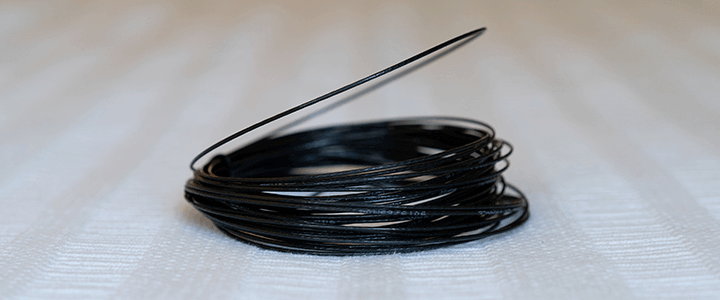Check out my custom vibration dampener
How to Choose Tennis Strings
A 5-Step Guide
We hope you love this article. Just so you know, TennisCompanion may collect a small share of sales from the links on this page to help keep this site running. Learn more.
Few players give tennis strings the credit they deserve. Yet, when playing, strings are the only point of contact between your racquet and the ball and therefore have a significant impact on performance. To get the most of your racquet, it pays to select a set of strings wisely.
In this article, we’ll teach you how to choose tennis strings with step-by-step guidance. Whether you’re selecting your first set or making a switch to something new, we’ve got you covered.
Article Contents
Click below to jump to a section
Tap below to jump to a section
Do Strings Matter?
Pick a Type of String
Determine a Gauge
Select a String
Identify a Tension
Find a Stringer
Replacing Tennis Strings
Hybrid Stringing
String Savers
New to TennisCompanion?
Create a free account and explore my latest videos below
Steps to Choosing a Tennis String
With hundreds of tennis strings on the market, it can be overwhelming to figure out where to start. However, by taking it step-by-step, we can quickly narrow down the options to find you a great string.
Here’s a quick recap of the steps we’ll walk through together:
- Pick a type of string
- Determine an appropriate gauge
- Select a string from popular brands
- Identify an appropriate tension
- Find a stringer
However, before we jump in, let’s tackle a question we often get from players that are new to the game.
Do Tennis Strings Really Matter?
Absolutely. Using the right strings that cater to your needs can help you perform at your best, improve arm health and longevity, and, more practically speaking, help you stick to your budget.
Of course, there’s a limit to the effect changing your strings will have, but customization and finding the right fit is a worthy endeavor. For example, if you’re looking to maximize control and topspin, then some strings will perform better than others for this purpose.
Earlier in your tennis career, your strings will have less of an impact on your overall performance. Instead, proper technique and repetition through practice will be the primary factors that determine how well you play. However, regardless of your level, we’re big advocates of players gaining the knowledge to make good decisions. For example, as a beginner, there are certain strings you’ll want to avoid.
Throughout this guide, we’ll dive into several areas that will help point you in the right direction. We’ll also touch on a few things to consider after you’ve purchased your new set of strings.
Helpful Tip
Hopefully, you’re already picked a racquet or are using one that you enjoy, which feels comfortable and aligns with your level and style of play. If not, we’d encourage you to start there. Here’s a link to our guide on how to choose the right tennis racquet.
Without further adieu, let’s jump into step number one.

Step 1: Pick a Type of String
When you’re shopping for tennis strings, the first step will be to decide between the two major categories of string: natural gut and synthetic.
As you may have guessed by the names, natural gut strings come from organic fibers, while synthetic come from artificial materials.
The most common materials used to make synthetic strings are nylon and polyester. You’ll also find a small selection of strings made with Kevlar, but they’re not as popular as they once were.
Natural Gut Tennis Strings
Natural gut strings are more expensive than synthetic, which makes them a less attractive choice for the vast majority of players.
This type of string has been around since the 1870s when Pierre Babolat first began creating them from sheep gut. These days, modern natural gut strings are made with cow intestine.
The molecular structure of natural gut strings gives them exceptional elasticity, especially compared to most synthetic strings, which results in excellent power, comfort, and feel.
For some, choosing natural gut strings might sound like a no-brainer, but they do come with drawbacks, including durability and high cost.
Pros
- Power
- Comfort
- Feel
- Tension stability
Cons
- Price
- Spin
- Durability
Recommendation
Natural gut strings are an excellent choice for experienced players looking for a high-end string that offers terrific performance and aren’t overly concerned with the durability of their strings.
On the other hand, if you’re a beginner, play casually or infrequently, or are on a tight budget, then these strings are unlikely to be a good fit. As a beginner or casual tennis player, you’ll be hard-pressed to detect the nuanced difference compared to their synthetic counterparts, so you might as well save yourself the cash.
Synthetic Tennis Strings
Synthetic strings offer a wide variety to choose from and are the ideal choice for most tennis players. However, not all strings in this category are created equal, and each comes with pros and cons.
If you opt for synthetic strings, you’ll have a few different options available to you. Here’s a breakdown of the most popular.
Synthetic Gut
Synthetic gut is an affordable group of nylon strings that are popular among beginner, intermediate, and recreational players. If you buy a pre-strung racquet off the shelf, it will usually come with nylon strings installed.
Most nylon strings feature a larger solid core construction with smaller outer wraps. The quality of nylon, exact construction, bonding agents, and coatings are some of the factors that result in a wide range of prices.
Pros
- Price
- Moderate all-around performance
Cons
- Durability
- Spin
- Feel
Recommendation
Synthetic gut strings are an excellent option for beginners and intermediate players due to their low cost and all-around performance. They’re also a solid option for casual or recreational players that aren’t overly concerned with string performance.
Polyester Strings
Polyester strings, or polys, have become one of the most popular choices on the pro tour, and you’ll find more options in this string category than any other.
These low powered strings are durable and stiff, which allows players to swing faster and generate more topspin without a loss in control. Moreover, when struck with enough force, the strings deform and then snap back into place, which helps further enhance topspin.
Unfortunately, the stiff nature of these strings results in one of their biggest downsides, and that’s comfort. Another pitfall is that they don’t do a great job of maintaining tension and require frequent replacement.
Pros
- Spin
- Control
- Durability
Cons
- Comfort
- Feel
- Tension stability
Recommendation
Polyester strings are ideal for intermediate to advanced players who have the skill and technique required to generate sufficient racquet head speed to take advantage of their befits. If you have a history of arm injuries, you’ll want to stay away from them.
Multifilament Strings
Manufacturers create multifilament strings by wrapping ultra-small nylon fibers together to make a single string. Due to their construction, they tend to hold their tension better than synthetic gut while seeking to mimic the power, comfort, and feel of natural gut.
Like polyester, what makes them great also leads to their downsides in that they can be overpowering or harder to control, while also lacking in topspin that many players desire.
Pros
- Power
- Comfort
- Feel
- Durability
Cons
- Spin
- Control
Recommendation
Multifilament strings are perfect for thriving beginners as well as intermediate and advanced tennis players looking for a high-powered string that provides excellent feel at a reasonable price. If you have a history of arm injuries, you’ll appreciate the comfort these strings offer.
Kevlar Strings
Kevlar strings use aramid fibers in their construction and are the stiffest and most durable available. If you have a history of breaking strings frequently, they make a great option.
However, because of their harsh feel, they come with the highest risk of causing arm injuries and, as a result, are the least popular.
Pros
- Durability
- Control
- Tension stability
Cons
- Comfort
- Feel
- Spin
Recommendation
If you’re a chronic string breaker that doesn’t have a history of arm injuries or discomfort, then you may want to experiment with Kevlar to increase the life of your strings.
However, we’d recommend you combine them with a softer synthetic gut or multifilament as part of a hybrid string setup where you install one type in the mains and another in the crosses (more on this to follow).

Step 2: Determine an Appropriate Gauge
Hopefully, in step one, you were able to find a tennis string that makes sense for you based on your level and performance preferences. As a quick recap, you would have selected one of the following:
- Natural gut
- Synthetic gut
- Multifilament
- Polyester
- Kevlar
Next up, you’ll need to select an appropriate gauge. In tennis, the gauge of a string refers to its size, or more specifically, a measure of its thickness or diameter.
In the US, a higher gauge refers to a thinner string, while a lower gauge refers to a thicker string. International gauges are the opposite.
The thinnest gauge in the United States is 22 or 2.5 international. On the other end of the spectrum, the thickest gauge in the United States is 13 or 12 if you’re going by international standards. Corresponding measurements range from 0.60 to 1.65 millimeters.
Keep in mind that this wide range of string gauges will not be available for all strings on the market – some are only available in one or two sizes.
| US Gagues | Int. Gauges | Measurements |
| 13 | 12 | 1.65 – 1.80 mm |
| 14 | 11 | 1.50 – 1.65 mm |
| 15 | 9.5 | 1.41 – 1.49 mm |
| 15L | 9 | 1.33 – 1.41 mm |
| 16 | 8.5 | 1.26 – 1.34 mm |
| 16L | 8 | 1.22 – 1.30 mm |
| 17 | 7.5 | 1.16 – 1.24 mm |
| 18 | 7 | 1.06 – 1.16 mm |
| 19 | 4 | 0.90 – 1.06 mm |
| 20 | 3.5 | 0.80 – 0.90 mm |
| 21 | 3 | 0.70 – 0.80 mm |
| 22 | 2.5 | 0.60 – 0.70 mm |
All else equal, a thicker string will provide you with increased durability, while a thinner string will help generate extra topspin because they have more “bite” or dig deeper into the ball.
However, it’s worth noting that most players in the early stages of their tennis careers will be hard-pressed to detect the subtle change in topspin performance from one gauge to another.
With that in mind, we recommend beginners start with something roughly in the middle, with 16 gauge being a great option that is widely available for most strings.
Ultimately, choosing a string gauge becomes a tradeoff that you’ll make based on preference. As your skills improve, you can work your way up or down in thickness to suit your needs for durability and spin.

Step 3: Select a String from Popular Brands
At this stage, you should have a specific type of string in mind, as well as a gauge that you’d like to try. Now for the fun part – selecting a string.
To help cut through the clutter, we’ve compiled our favorite three strings from top tennis brands for every type we’ve covered. Also, since the availability of gauges differs, we’ve listed those as well.
Simply find the type of string you’ve selected below, and pick one of the three we’ve rounded up. If you’re new to tennis, don’t overthink it. Each string we’ve selected is best-in-class, so you can be confident any you choose will be a great choice.
Natural gut
| String | Gauges |
| Babolat VS Touch | 17, 16 |
| Luxilon Natural Gut | 17, 16 |
| Wilson Natural Gut | 17, 16 |
Synthetic gut
| String | Gauges |
| Gosen OG Sheep Micro | 18, 17, 16 |
| Prince Synthetic Gut | 17, 16, 15L |
| Gamma TNT2 | 18, 17, 16, 15L |
Multifilament
| String | Gauges |
| Babolat Origin | 17, 16 |
| Tecnifibre X-One Biphase | 18, 17, 16 |
| Wilson NXT | 17, 16 |
Polyester
| String | Gauges |
| Babolat RPM Blast | 18,17 ,16 ,15L |
| Luxilon ALU Power | 16L, 15 |
| Head Sonic Pro Edge | 17, 16 |
Kevlar
| String | Gauges |
| Prince Pro Blend | 16 |
| Gamma TNT2 Fusion Plus | 12 |
| Ashaway Crossfire | 18, 17 |
Of course, if you’re up for it, we’d encourage you to explore other tennis strings in each category. Be sure to check out our guide for the best tennis strings in 2020 for a selection of our top picks.

Step 4: Identify an Appropriate Tension
After you selected a tennis string, you’re almost across the finish line, but there are a few more things to keep in mind, starting with tension.
String tension is a measure of how tightly a stringer pulls your strings as they’re attached to your racquet. In the United States, string tension is measured in pounds, but you’ll find kilograms as the standard unit of measurement everywhere else in the world.
Generally, you’ll find string tension ranges between 35 to 70 pounds or 15.88 to 31.75 kilograms. Higher tension will provide you with more control, while a lower tension will increase your power.
That may appear a broad range to choose from, but there’s a simple way to narrow your choices down. That is, most premium tennis racquets come with a recommended tension range listed on the inside edge of your frame, i.e., 50 to 60 pounds or 23 to 27 kilograms.
Another place to check is on the package of the strings you choose. Sometimes they’ll display a recommended tension range as well, which will typically fall within the acceptable ranges of your racquet.
As a beginner, we recommend splitting the difference and starting at the halfway point. In our example above, 55 pounds would be a great choice. Once you’ve experienced hitting at that tension, you can then increase or decrease it based on your preference.
Some strings, such as polyester, perform well at lower tension, which you’ll want to consider as you move from one type of string to another. Check out our guide on string tension if you’d like to learn more.

Step 5: Find a Stringer
At this point, you should be just about ready to go, but there’s one last step, and that’s finding someone to string your tennis racquet.
There are a variety of places to find a stringer, but for many, the most obvious will be your local tennis shop or club. If you have one near-by, they might be a great option for you.
You might also check with your local big box sporting goods store to see if they offer string services as some do. However, be sure to verify that the person doing the stringing is well qualified for the job.
Last but not least, you can check RacquetTech’s directory of certified tennis stringers, which may include a local tennis coach, instructor, or passionate player who offers the service.
At this point, you should be all set, but there are a few other topics we’ve included that we think you’ll find helpful as it relates to strings.
Replacing Tennis Strings
After installation, your strings will begin to lose tension, which will continue as you start to play with them. They’ll also lose their resilience and go “dead” over time, which simply means they’ve lost their elasticity and no longer perform.
Somewhat surprisingly, strings can lose up to 10% of their tension within the first 24 hours. For professional players who get their racquets strung every time before you hit the court, it’s not much of a concern. However, the rest of us need to keep an eye on our strings to perform our best.
As a general rule of thumb, you can take the number of times you play per week and double it to determine how often you should string per year. As an example, if you play three times per week, you’ll want to string your racquet at least six times per year or every two months.
While the above method is imperfect, we find it tends to get most players in the right ballpark. You can then take into consideration factors such as duration of play and how aggressively you strike the ball and adjust from there. At a minimum, we suggest you replace your strings twice a year.
To help determine when it’s time, you can check your strings for visual cues and keep tabs on the feel of your racquet as well. If your strings form deep notches at the cross-sections or they’re fraying and look like they’re on their last leg, then it’s probably time to resting. Furthermore, if you’re sensing a loss in control, spin, or crisp feel, then those factors can also help you determine when it’s time to string.
Ideally, you’ll restring before your strings break.
Hybrid Stringing
In your quest to find the perfect set of tennis strings, you may come across the concept of hybrid stringing, which is popular among professional and amateur tennis players.
Hybrid stringing refers to installing one type of string in the mains and another kind of strings in the crosses. The general idea is to get the combined benefit of different strings, i.e., the comfort of a multifilament coupled with the durability and spin of a polyester.
Any two strings can be installed within a racquet to form a hybrid, but here are the most common setups:
- Natural gut and polyester
- Multifilament and polyester
- Synthetic gut and polyester
It’s worth noting that whichever string you install for the mains will dominate the overall feel and performance.
String Savers
These days, string savers aren’t nearly as popular as they once where, but they’re still in use, and you may come across them.
String savers are small plastic devices installed at the cross-sections between strings to save them from wear and tear.
Every time you hit a ball, your strings rub against each other, which causes friction and can lead to premature breakage. If you notice your strings repeatedly breaking in roughly the same locations, you can install string savers to protect and extend their life.
Opinions differ, but adding string savers may cause a slight deadening in the feel of your strings, similar to when you use a vibration dampener.
They also increase your string tension slightly. If you decide to use string savers but want to keep the same tension, you’ll need to decrease your tension by a few pounds depending on the number you install.
Although professional players replace their strings often, some pros still use string savers because they like the feel. Two active players that have used them for years include Roger Federer and Grigor Dimitrov. Pete Sampras was also well known for using them.
If you think you might benefit, they’re inexpensive to try. Plus, string savers uninstall as quickly without replacing your strings if you don’t like the feel.
Wrapping Up
Keep in mind that while your racquet is essential, your strings are the only thing that touches the ball when hitting, so it’s worth giving them sufficient consideration to perform at your best.
No string will make up for years of hard work and practice; however, choosing the right string can help you maximize your performance, improve your comfort, and save you money too.
Now that you know how to choose tennis strings, we recommend you experiment with different types, gauges, and tensions to get a feel for the nuances of each. The more skilled you become, the better you’ll get at detecting and appreciating the subtle differences.
Have questions? We’d love to help in the comments below!
Play Better Tennis
Improve your game alongside our community of tennis players
Why join?
Discussion Boards
Join the conversation with other members of the community.
5 Point Friday
Read our weekly recap of the 5 most interesting things we dig up in tennis.



Leave a Reply
Want to join the discussion?Feel free to contribute!